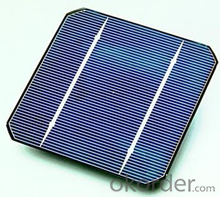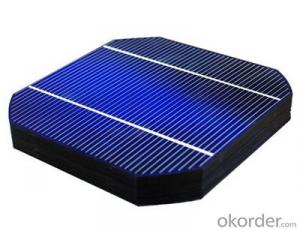Solar Cells for Boats - Monocrystalline Silicon Solar Cells 156mm (14.00%-17.25%)
- Loading Port:
- Shanghai
- Payment Terms:
- TT OR LC
- Min Order Qty:
- 1000 watt
- Supply Capability:
- 100000000 watt/month
OKorder Service Pledge
OKorder Financial Service
You Might Also Like
Specification
1.Description of the Solar Cells
Monocrytalline Silicon Solar Cells 156mm (14.00%----17.25%)
We supply regular mono 125x125mm and poly 156x156mm solar cells.
Cells made in China mainland and Taiwan are both available.
Cell production capacity yearly reach 1GW.
Our cells pattern include continuous and uncontinuous busbar to meet different cells line.
2.Mechanical data and design of the Solar Cells
| Format | 156 mm × 156 mm ± 0.5 mm |
| Thickness- | 210 μm ± 40 μm |
| Front (-) | 1.5 mm bus bars (silver),blue anti-reflection coating (silicon nitride) |
| Back (+) | 2.5 mm wide soldering pads (silver) back surface field (aluminium) |
3. Temperature Coefficient of the Solar Cells
| Voc. Temp .coef.%/K | -0.351%/K |
| Isc . Temp .coef.%/K | +0.035%/K |
| Pm. Temp. coef.%/K | -0.47%/K |
4.Electrical Characteristic of the Solar Cells
Efficiency (%) | Pmpp (W) | Umpp (V) | Impp (A) | Uoc (V) | Isc (A) | FF (%) | ||
17.25 | 4.197 | 0.524 | 7.992 | 0.62 | 8.458 | 80.03% | ||
17 | 4.137 | 0.524 | 7.876 | 0.619 | 8.353 | 80.01% | ||
16.75 | 4.076 | 0.522 | 7.81 | 0.617 | 8.286 | 79.73% | ||
16.5 | 4.015 | 0.518 | 7.746 | 0.613 | 8.215 | 79.73% | ||
16.25 | 3.955 | 0.515 | 7.683 | 0.61 | 8.144 | 79.61% | ||
16 | 3.894 | 0.512 | 7.613 | 0.608 | 8.075 | 79.31% | ||
15.75 | 3.833 | 0.51 | 7.534 | 0.605 | 8.058 | 78.62% | ||
15.5 | 3.772 | 0.508 | 7.453 | 0.604 | 8.02 | 77.87% | ||
15.25 | 3.711 | 0.505 | 7.35 | 0.604 | 7.997 | 76.83% | ||
15 | 3.65 | 0.503 | 7.271 | 0.604 | 7.989 | 75.64% | ||
14.5 | 3.529 | 0.499 | 7.067 | 0.604 | 7.988 | 73.14% | ||
14 | 3.407 | 0.499 | 6.833 | 0.604 | 7.833 | 72.01% | ||
5.Intensity Dependence of the Solar Cells
Intensity [W/m2] | sc× [mA] | Voc× [mV] |
1000 | 1.00 | 1.000 |
900 | 0.90 | 0.989 |
500 | 0.50 | 0.963 |
300 | 0.30 | 0.939 |
200 | 0.20 | 0.920 |
6.Applications of the Solar Cells
electric power generation
7.IMages of the Solar Cells



FAQ
- Q: What is the role of anti-reflective coatings in solar cells?
- The role of anti-reflective coatings in solar cells is to minimize the reflection of sunlight that hits the surface of the solar cell. By reducing reflection, more light can be absorbed by the solar cell, thus increasing its overall efficiency and power output. This allows for better utilization of sunlight and helps to maximize the energy conversion process in solar cells.
- Q: What is the role of solar cells in powering traffic signals?
- Solar cells play a crucial role in powering traffic signals as they convert sunlight into electricity, which is then used to operate the signals. By harnessing renewable energy, solar cells eliminate the need for grid connection or reliance on fossil fuels, making traffic signals more sustainable and cost-effective.
- Q: How do solar cells perform in urban environments?
- Solar cells can perform well in urban environments, although their efficiency may be slightly reduced compared to rural or open areas due to factors like shading from buildings and pollution. However, advancements in technology and design have made urban solar installations more efficient by utilizing innovative mounting options and optimizing solar panel angles. Additionally, the increasing number of rooftop solar installations in cities has enabled effective utilization of available space and contributed to the growth of renewable energy in urban areas.
- Q: Can solar cells be used for cooking?
- Yes, solar cells can be used for cooking, but not directly. Solar cells generate electricity from sunlight, which can then be used to power electric stoves or other cooking appliances.
- Q: What is the typical size and weight of a solar cell?
- The typical size of a solar cell ranges from a few square centimeters to several square meters, depending on its application. In terms of weight, solar cells are generally lightweight, weighing anywhere from a few grams to a few kilograms, again depending on their size and technology.
- Q: Can solar cells be used for powering security systems?
- Yes, solar cells can definitely be used for powering security systems. Solar panels can convert sunlight into electricity, providing a renewable energy source to power security cameras, alarms, and other security devices. This eliminates the need for a constant electrical supply or batteries, making it a cost-effective and environmentally friendly solution for powering security systems.
- Q: Can solar cells be used for telecommunications infrastructure?
- Yes, solar cells can indeed be used for telecommunications infrastructure. Solar cells can generate electricity from sunlight, which can be used to power various telecommunications equipment such as cell towers, base stations, and repeaters. This renewable energy source helps reduce dependence on traditional power sources, increases energy efficiency, and can even enable telecommunication services in remote or off-grid areas where grid power is unavailable.
- Q: How do solar cells perform in cloudy weather?
- Solar cells can still generate electricity in cloudy weather, although their efficiency is reduced compared to sunny conditions. Cloud cover limits the amount of sunlight reaching the solar panels, resulting in a lower energy output. However, modern solar cell technologies are designed to capture diffused sunlight and can still produce a significant amount of electricity even in cloudy weather.
- Q: How do solar cells perform in snowy conditions?
- Solar cells typically perform less efficiently in snowy conditions. The accumulation of snow on the surface of solar panels obstructs the incoming sunlight, reducing the amount of energy that can be converted into electricity. Additionally, the cold temperatures can also decrease the overall performance of solar cells. However, some modern solar panels are designed to be more snow-resistant and have special coatings that allow snow to slide off more easily, which helps to maintain their efficiency to some extent.
- Q: Can solar cells be used in remote communication systems?
- Yes, solar cells can be used in remote communication systems. Solar cells are capable of converting sunlight into electrical energy, which can power various communication devices such as radios, satellites, and weather monitoring systems. This makes them an ideal solution for remote areas where access to traditional power sources may be limited or nonexistent. Additionally, solar cells can provide a sustainable and environmentally friendly alternative to traditional energy sources, reducing dependence on fossil fuels.
Send your message to us
Solar Cells for Boats - Monocrystalline Silicon Solar Cells 156mm (14.00%-17.25%)
- Loading Port:
- Shanghai
- Payment Terms:
- TT OR LC
- Min Order Qty:
- 1000 watt
- Supply Capability:
- 100000000 watt/month
OKorder Service Pledge
OKorder Financial Service
Similar products
Hot products
Hot Searches
Related keywords


































